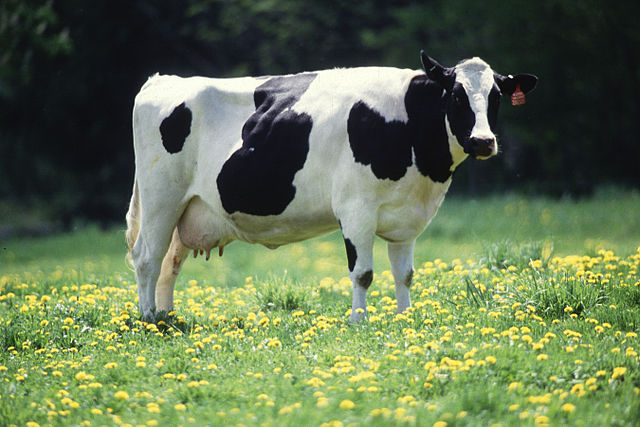Million Dollar Moo

An average milk cow produces the equivalent of 350,000 cups of milk over her lifetime, according to the Food Animal Education Network at Purdue University. During the U.S. “fiscal cliff” showdown at the end of 2012, some argued that a failure to come to a political compromise could could spike the price of a gallon of milk — 16 cups — to $8. So a typical milk cow, at most, produces about $175,000 worth of milk over its lifespan. That’s a lot of money, but it comes at the cost of a lot of work, a lot of land, and a lot of other expenses. (And it takes a long time, too.) The typical milk cow costs in the range of $500 to $1,500.
Taking the high end, that makes a cow named Mist worth about 1,000 regular cows.
In July of 1985, Mist, a Holstein cow (most milk cows are Holstein cows), was placed on the auction block by its owner, a Boston-area lawyer named Jerry Rappaport. She wasn’t like typical Holsteins, though. Mist, as the New York Times reported, had a fantastic pedigree and “her milk [had] a high butterfat content,” a leading factor for the economic viability of a cow. Perhaps more importantly, though, Mist was pregnant with 14 viable cow embryos — each of which (obviously) carried her genetic makeup and therefore came with the promise of being outstanding in their own right. The winning bidder, a group led by Rappaport, ponied up $1.3 million for the cow. (Why he structured the transaction this way is anyone’s guess.) The price was a record at the time, and one that likely still stands.
Mist’s embryos were successfully implanted in other cows, which acted as surrogates and gave birth to a clan of highly sought-after cattle. In a follow-up story in November of the same year, the Times reported that Mist had four offspring already by that point — three bulls and a heifer. Rappaport told the Times that one of the bulls had already started to earn back the $1.3 million price tag (even though he paid it to himself, in large part) — it was leased to a Canadian company and used as a stud. Rappaport explained the economics: “It’s an open-ended lease. It calls for a percentage – up to 50 percent -of all the semen sales. The semen sales from a successful bull could run up to $1 million a year.”
Whether Mist ended up being worth anywhere near her price tag is unreported. According to a profile of Rappaport in industry publication Holstein World (here’s a .pdf), Mist passed away a few years ago and was cremated. A tombstone in her memory is outside the milk barn at Rappaport’s farm.
Bonus fact: The Maasai are a group of about half a million semi-nomadic cattle ranchers in Tanzania and Kenya. After 9/11, they learned of the attacks via the radio, but did not truly appreciate the horror until months later when one of their members, who had been studying in the U.S., came back and told the others about the events. The Maasai decided to do something about — one of the few things they could — and gifted 14 cattle to the United States.
From the Archives: This Cheese Stands Alone: Really, really expensive cheese. Not from Mist. Not from a cow at all, in fact.
Related: Amazon doesn’t sell milk cows (which is surprising given that they sell basically everything else, even ladybugs in bulk), but they do sell a lot of cow-related items.
